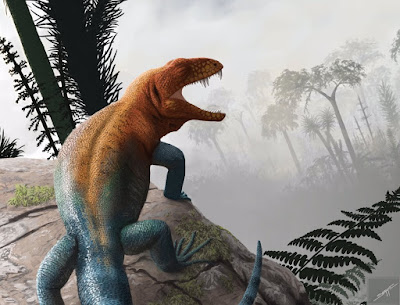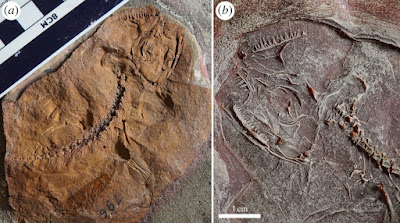|
|
| Пишет Species New to Science ( @ 2021-05-17 10:25:00 |
|
|
|
|
|
|
|
|
|
|
|
|
|
|
[Paleontology • 2019] Carbonodraco lundi • the Oldest Parareptile (Amniota: Parareptilia), from Linton, Ohio, and New Insights Into the early Radiation of Reptiles
 |
| Carbonodraco lundi Mann, McDaniel, McColville & Maddin, 2019 DOI: 10.1098/rsos.191191 |
Abstract
Redescription of the holotype specimen of Cephalerpeton ventriarmatum Moodie, 1912, from the Middle Pennsylvanian (Moscovian) Francis Creek Shale of Mazon Creek, Illinois, confirms that it is a basal eureptile with close postcranial similarities to other protorothyridids, such as Anthracodromeus and Paleothyris. The skull is long and lightly built, with large orbits and a dorsoventrally short mandible similar to most basal eureptiles. Two specimens referred previously to Cephalerpeton cf. C. ventriarmatum from the approximately coeval Linton, Ohio, locality differ significantly from the holotype in cranial and mandibular proportions and tooth morphology. This material and an additional Linton specimen compare favourably to ‘short-faced’ parareptiles, such as Colobomycter and Acleistorhinus, and justify recognition of an acleistorhinid parareptile in the Linton assemblage. The new binomen is thus the oldest known parareptile.
Keywords: Pennsylvanian, Amniota, Carboniferous, Mazon Creek, Parareptilia, Eureptilia
Subjects
 |
| Figure 1. Cephalerpeton ventriarmatum (YPM 796), (a) original nodule (cranium in ventral aspect: postcranium in dorsal lateral aspect) and (b) resin cast of the original nodule. |
Systematic palaeontology
Tetrapoda Jaekel, 1909
Amniota Haeckel, 1866
Parareptilia Olson, 1947
Acleistorhinidae Daly, 1969
Carbonodraco gen. nov.
Carbonodraco lundi sp. nov.
=Cephalerpeton cf. C. ventriarmatum Reisz and Baird 1983
Etymology: Generic name derived from the Latin words ‘Carbo’ (coal), and ‘Draco’ (serpent). Specific name is in honour of Dr Richard Lund, who found the holotype.
 |
| Figure 4. Illustration of the cranial anatomy of the holotype of Carbonodraco lundi gen. et sp nov. (CM 23055), and a reconstruction. |
 |
| Figure 3. Carbonodraco lundi gen. et sp. nov., (a) the holotype specimen (CM 23055) (Amy C. Henrici photo) and (b) latex peel of the holotype specimen. |
Arjan Mann, Emily J. McDaniel, Emily R. McColville and Hillary C. Maddin. 2019. Carbonodraco lundi gen et sp. nov., the Oldest Parareptile, from Linton, Ohio, and New Insights Into the early Radiation of Reptiles. Royal Society Open Science. 6 (11): 191191. DOI: 10.1098/rsos.191191



